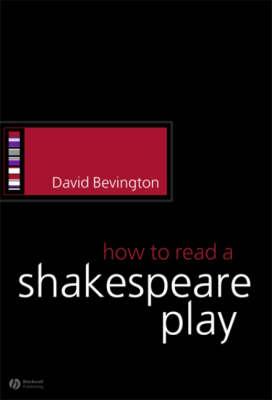Overview
This clear and succinct book is designed for general readers who want to know how to go about reading Shakespeare’s works for pleasure. Encourages readers to approach Shakespeare's works aggressively, interactively, and questioningly Focuses on six popular Shakespeare plays - A Midsummer Night’s Dream, Romeo and Juliet, Henry IV Part I, Hamlet, King Lear and The Tempest Recommends the best editions, recordings and DVDs / videos of these plays Discusses the production of the plays on stage and screen Introduces readers to different genres in Shakespeare – romantic comedy, English history, tragedy and romance Avoids jargon and abstract literary theory
Full Product Details
Author: David Bevington (University of Chicago)
Publisher: John Wiley and Sons Ltd
Imprint: Wiley-Blackwell
Dimensions:
Width: 15.50cm
, Height: 1.10cm
, Length: 23.10cm
Weight: 0.281kg
ISBN: 9781405113960
ISBN 10: 1405113960
Pages: 180
Publication Date: 02 June 2006
Audience:
Professional and scholarly
,
Professional & Vocational
Format: Paperback
Publisher's Status: Active
Availability: Out of stock

The supplier is temporarily out of stock of this item. It will be ordered for you on backorder and shipped when it becomes available.
Reviews
In just a few pages, the author manages to unearth the full richness of the Bard, opening the reader's mind and asking questions rather than providing glib, easy answers. This is a terrific beginner's volume for the novice English literature student tasked with studying the works of William Shakespeare, and a valuable re-entry point for the intermediate Shakespeare reader looking for additional analytical methods. (Simply Shakespeare, November 2009) ?The first chapter is a fabulous, full-frontal, thirteen-page assault that both dispenses information and suggests effective questions that student readers might employ when reading a text in order to ?read aggressively? (p. 9). What is mildly revolutionary is that it is here, in print, ready to be easily disseminated to students and thus to more easily and readily articulate the type of engagement with a text that we hope and expect our students will undertake. Bevington challenges his readers to think in historical, theatrical, and characterological terms. Bevington?s list is instructive and at times brutally honest. Schools should consider investing heavily in this text for the benefit of their pupils; college or university-level students would also be aided by Bevington?s straightforward, avuncular reading advice.? (Year's Work in English Studies, 2008)
"""In just a few pages, the author manages to unearth the full richness of the Bard, opening the reader's mind and asking questions rather than providing glib, easy answers. This is a terrific beginner's volume for the novice English literature student tasked with studying the works of William Shakespeare, and a valuable re-entry point for the intermediate Shakespeare reader looking for additional analytical methods."" (Simply Shakespeare, November 2009) ""The first chapter is a fabulous, full-frontal, thirteen-page assault that both dispenses information and suggests effective questions that student readers might employ when reading a text in order to 'read aggressively' (p. 9). What is mildly revolutionary is that it is here, in print, ready to be easily disseminated to students and thus to more easily and readily articulate the type of engagement with a text that we hope and expect our students will undertake. Bevington challenges his readers to think in historical, theatrical, and characterological terms. Bevington's list is instructive and at times brutally honest. Schools should consider investing heavily in this text for the benefit of their pupils; college or university-level students would also be aided by Bevington's straightforward, avuncular reading advice."" (Year's Work in English Studies, 2008)"
In just a few pages, the author manages to unearth the full richness of the Bard, opening the reader's mind and asking questions rather than providing glib, easy answers. This is a terrific beginner's volume for the novice English literature student tasked with studying the works of William Shakespeare, and a valuable re-entry point for the intermediate Shakespeare reader looking for additional analytical methods. (Simply Shakespeare, November 2009) “The first chapter is a fabulous, full-frontal, thirteen-page assault that both dispenses information and suggests effective questions that student readers might employ when reading a text in order to ‘read aggressively' (p. 9). What is mildly revolutionary is that it is here, in print, ready to be easily disseminated to students and thus to more easily and readily articulate the type of engagement with a text that we hope and expect our students will undertake. Bevington challenges his readers to think in historical, theatrical, and characterological terms. Bevington's list is instructive and at times brutally honest. Schools should consider investing heavily in this text for the benefit of their pupils; college or university-level students would also be aided by Bevington's straightforward, avuncular reading advice. (Year's Work in English Studies, 2008)
Author Information
David Bevington is Professor Emeritus at the University of Chicago. His recent publications include Shakespeare: The Seven Ages of Human Experience (second edition, 2005) and Shakespeare: Script, Stage, Screen (with Anne Marie Welsh and Michael L. Greenwald, 2006). He has also edited the Bantam Shakespeare in 29 volumes (currently being reedited), The Complete Works of Shakespeare (fifth edition, 2003), and a number of individual Shakespeare plays including Antony and Cleopatra, Henry IV, Part I, and Troilus and Cressida.




